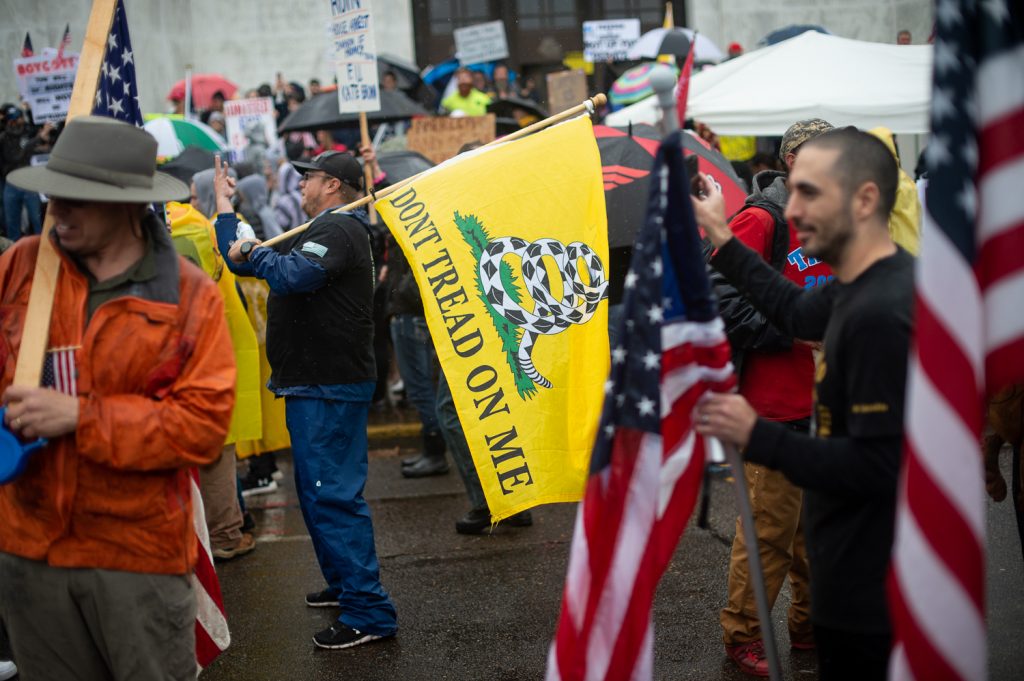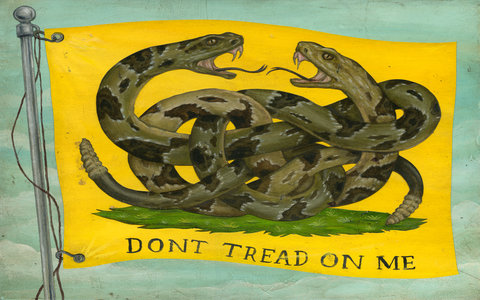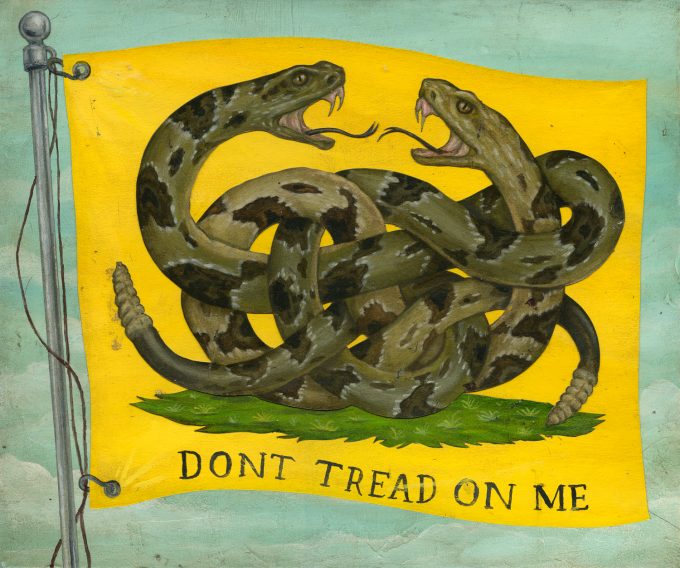The year was 2017, the month was August. America was 241 years old, and totems of its racist past were crumbling.
One of the Northwest’s largest tributes to Confederate soldiers — an 8-foot-high marble fountain erected in Helena, Montana, in 1916 — was about to come down, too. To protest its removal, a small group of Montanans rallied at the fountain, waving signs and flags: Confederate flags, but also the bright-yellow, unmistakable Gadsden flag, the Revolutionary War banner with a coiled rattlesnake at its center atop the words “Don’t Tread on Me.”
“Tyranny … you’re watching it unfold right here,” one man told reporters.
That summer, Confederate monuments were falling across the country after a woman was killed by a white supremacist at the Unite the Right rally in Charlottesville, Virginia. The Charlottesville demonstrators, too, waved banners: Confederate, Nazi and, again, the Gadsden flag. Afterward, the Montana state Legislature’s eight-person American Indian Caucus authored a letter urging removal of the Helena fountain. “Public property in Montana should not be used to promote Nazism, fascism, totalitarianism, separatism, or racism,” they wrote.
According to the Helena protesters, removing the fountain meant rewriting history. State Rep. Shane Morigeau, one of the letter’s authors, spoke out against that idea. Morigeau — a Democrat who is running for state auditor this year and is an enrolled member of the Confederated Salish and Kootenai Tribes — says context is everything. “We know what the Confederacy stood for and what people who fly the Confederate flag — what the meaning is to them.”
But when the protesters waved the Gadsden flag, Morigeau found the message confusing. The bright yellow banner is not a Civil War symbol; rather, its forthright message read like a dare, a taunt — sort of a Colonial-era “Come at me, bro” — aimed at the British during the American Revolution.
In recent years, however, the classic rattlesnake flag has come to mean something very different. Some of the most violent and vehemently anti-government figures in the West have recast the ready-to-strike rattlesnake as a warning against the American government itself. Still, some Montanans say they’re not ready to cede the Gadsden flag to those who would use it as the new logo for right-wing extremism.
For Jamar Galbreath, who works for Empower Montana, a nonprofit dedicated to combating injustice, the Gadsden flag evokes something sinister: a 1846 Edgar Allen Poe story, “The Cask of Amontillado.” In it, a man pledges revenge on another man. While luring his victim toward his death, he speaks of his family coat of arms: a snake biting the foot that is stepping on its body, with the Latin words Nemo me impune lacessit — “No one strikes me with impunity.”
“Every time I see that flag, I think about that,” Galbreath said. “Who is crushing who?”
THE YEAR WAS 1751, the month was May. America wasn’t a formal thing yet, but colonists seeking independence from the British were growing weary of the Crown’s continual meddling on this side of the ocean.
That month, an editorial ran in the pages of Benjamin Franklin’s Pennsylvania Gazette, floating an idea for an act of revenge. Britain was using North America as a penal colony, shipping felons over by the boatload. The editorial suggested paying colonists to catch rattlesnakes, which would then be corralled onto ships headed for England. There was something about a beast that slithered and poisoned that appealed to those early Americans. It wasn’t regal, but it was fearsome.
Three years later, Franklin published a political cartoon in The Gazette, depicting Colonial America as a rattlesnake that had been hacked into eight parts, each labeled with the name of a colony. Below the image was a message: “JOIN, or DIE.” Alongside it, an article argued that the colonial governments must band together, lest they be sliced to pieces. “That kind of solidified it, in a way, as a symbol of rebellion against the British,” said Marc Leepson, a historian and author of the book, Flag: An American Biography.
Historians point to Christopher Gadsden — a slave-owning South Carolinian — as the namesake for the iconic yellow flag. Gadsden, a colonel in the Continental Army, is believed to have gifted the Commander of the Navy with a flag to fly above his fleet. Over time it was adopted by the other armed forces. But by the 20th century, the rattlesnake flag had found favor with extremists: In the late 1960s, Ku Klux Klan leaders embraced it, and in the 1970s, organizers of the radical environmental group Earth First! gave speeches from Gadsden-draped stages.
In 2009, the flag started popping up at Tea Party meetings across America. In adopting the Gadsden as its symbol, the party redefined the one doing the treading to fit its message: The treader was no longer foreign, but domestic.
It was around this time that the Gadsden rattlesnake also slid its way onto laser-etched gun accessories, hats and the arm tattoos of Second Amendment advocates. In response, the flag became the subject of endless Internet memes. A rudimentary, pencil-drawn spoof of it appeared on 4Chan, an online forum devoted to crass imagery: “No Step on Snek,” it read — the misspelling intentional, as if to poke further fun at those embracing the flag as theirs.
With the Gadsden as its logo, gun rights advocates and Tea Partiers were claiming righteousness. “(They) feel that they’re the true Americans,” Theda Skocpol, a Harvard professor and co-author of The Tea Party and The Remaking of Republican Conservatism, told me. “The most common thing people said to us in our interviews was, ‘We are working to save America.’ ”
THE YEAR WAS 2014, the season was spring. America was 238 years old, and the militia movement was about to score a victory in its decades-long fight against the federal government.
By then, anti-government groups were locked in a cycle of violence and revenge with the feds that continues today. Militia activity surged in the 1990s after federal agents shot and killed Vicky Weaver and her teenage son during the high-profile Ruby Ridge standoff, in Idaho. It lurched forward further when federal agents stormed the Branch Davidian compound in Waco, Texas, killing 76 civilians. As payback, Timothy McVeigh bombed the Alfred P. Murrah federal building in Oklahoma City, killing 168 people, in April 1995.
These stories were still in the air when Jerad and Amanda Miller, husband-and-wife street performers, arrived in the dusty desert town of Bunkerville, Nevada, in April 2014. They came for a protest at a small cattle ranch and melon farm, where an old rancher claimed the next Waco was brewing.
Cliven Bundy, for 20 years, had neglected to pay grazing fees to the Bureau of Land Management, citing his belief that the federal government couldn’t own land. When it appeared that the BLM was finally going to impound his cattle, Bundy called on militias for help. They came, their members bearing .50 caliber machine guns and Gadsden flags. “I really don’t want violence toward (the government),” Jerad Miller told a TV reporter. “But if they’re gonna come bring violence to us? Well, if that’s the language they want to speak, we’ll learn it.”
Six weeks later, the Millers walked into a Las Vegas pizza parlor and shot two police officers. They draped one of the bodies in a Gadsden flag and a swastika, pinning a note to the other: “This is the beginning of the revolution,” it read.
In 2017, a man named Jeremy Christian thrust Nazi salutes into the spring air at an alt-right march in Portland, Oregon, while all around him people waved Gadsden flags. Weeks later, Christian lobbed racial slurs at two teenage girls on a crowded commuter train. When three other passengers confronted him, Christian slashed their throats with a knife, killing two of them. In court, where he would be convicted of murder, Christian was photographed holding up a small Gadsden flag.
“It’s become a symbol of anti-government, Patriot and militia members,” Travis McAdam, program director at Montana Human Rights Network, told me. The revival and repurposing of the Revolutionary symbol makes sense to McAdam: “So many of the militia folks that are out there view themselves as the modern-day version of this country’s founders.”

A person displays a Gadsden flag during a Reopen Oregon rally outside of the State Capitol building in Salem, Oregon, on May 2, 2020. Hundreds gathered at the hours long event demanding Oregon reopen businesses during Gov. Kate Brown’s stay-at-home order.
Ed Glazar
THE YEAR WAS 2020, the month was April. America was 244 years old, and the struggle for control over an American symbol of freedom was far from over.
From Olympia, Washington, to Lansing, Michigan, Gadsden flag-carrying protesters railed against COVID-19 stay-at-home orders handed down by state governments. Ammon Bundy, son of the Nevada rancher, even sermonized about the flag in Emmett, Idaho, where he had gathered a group of people who deemed the virus harmless and the restrictions tyrannical.
“On the Gadsden flag we have a snake, and it says, ‘Don’t tread on me.’ We’re gonna flip that around. What we want to become, what we will become, we are going to be like a den of rattlesnakes,” Bundy said. “We will be so venomous if our rights are even threatened one bit!”
The way the flag was being embraced by extremists reminded Morigeau, the Montana representative, of the fight to remove the Confederate monument in Helena — as if it was another chapter in the same book. Like that monument — erected long after the war’s end, far from any Civil War battlefield — the Gadsden flag has come to function as an extremist dog whistle: “Things can take on new meaning. It can be used as a tool,” he said. “Some people are trying to take liberty and defiance to the extreme.”
“There’s a moment where we have to step up, too, and talk about the real history on this and not let these people … make it a symbol of hate,” he told me. “I might just go buy a damn flag now and put a sticker on my car because of this conversation.”
Later that day, Morigeau texted me an Amazon link for a $6.99 vinyl Gadsden flag sticker. “A great way to showcase your political views!” the description read. By the next week, he’d affixed it to the window of his pickup. He texted me a photo, along with a note: “I’m not going to let the Tea Party repurpose a flag and tread on its universal meaning.”
In Montana, conversations about the flag often do come down to car decorations. In 2017, Montana became the only state in the West to offer residents the option to put a bright yellow “Don’t Tread on Me” specialty license plate on their vehicle. As of March 2020, nearly 2,800 Montanans had one.
The plate was the creation of a Billings nonprofit called the 1776 Foundation, which is focused on upholding “traditional American values, historic civil liberties, the Montana Constitution and the Constitution of the United States of America.” The organization — which did not respond to multiple requests for comment from High Country News — earned $61,000 from the plates in 2019 alone.
The nonprofit is the work of Jacob Eaton, a combat veteran and campaign manager for Republican Rep. Greg Gianforte’s gubernatorial run. Eaton served as the executive director of the Montana GOP until 2008, when he stepped down in a flurry of controversy after unsuccessfully challenging the validity of 6,000 voter registrations — particularly of Indigenous people and residents of liberal-leaning counties — in federal court. The state GOP backed off, but not before U.S. District Court Judge Donald Molloy took a swing at Eaton: “One can imagine the mischief an immature political operative could inject into an election cycle,” he wrote, “were he to use the statutes, not for their intended purpose of protecting the integrity of the people’s democracy, but rather to execute a tawdry political ploy.”
Around the state, the Gadsden plates are perceived as a symbol loaded with conflicting messages — even to those who know the emblem’s history.
A member of a proud military family, William “Bill” Snell Jr., who lives in Billings, Montana, and is an enrolled Crow tribal member, grew up respecting the Gadsden flag. And even though his reverence for the flag is lifelong, Snell says he would not fly one — or put the plate on his car. “I think people would label me. And I really don’t need that,” he said. “I would definitely fly some other flags, including tribal flags, but that particular flag I probably wouldn’t, just because of the misinterpretation it might bring to me and my family.”
Still, his attitude toward the flag might help explain its persistence, and its ominous warning. “It demonstrates strength; it demonstrates authority,” Snell said. “To me, it indicates that whole philosophy that everything is good, but don’t mess with us in a bad way. … If you see a nail, don’t step on it. Because there’s a consequence. There’s always a consequence.”
Leah Sottile is a correspondent at High Country News. She writes from Portland, Oregon.
–hcn.org




